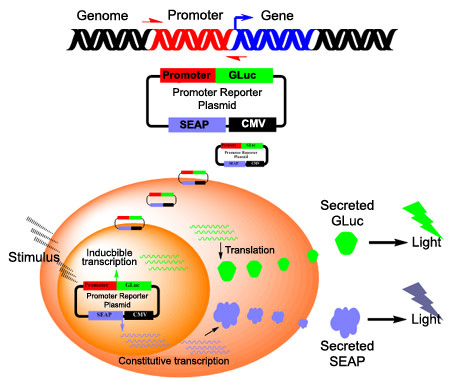Non-invasive manipulations of intracellular processes have recently appeared as an emerging research field. Experts in the development of biosensors for live cell discovery, Montana Molecular provide an Optogenetic toolkit to easily control cAMP levels in your cell by light.
By definition, Optogenetics is the use of light to control biological processes in living cells. Based on photo-activable enzymes, this emerging field allows researchers to simply modify and record cellular processes at a high spatio-temporal resolution.
Specialists in the development of innovative and fluorescent biosensors to easily measure parameters such as DAG, PIP2, Ca2+, voltage changes in living cells, Montana Molecular have developed a complete Optogenetic toolkit, to optically elevate intracellular cAMP, measure changes in cAMP and calcium, and create excitable HEK cells.
As described in our previous post, the Montana Molecular technology uses fluorescent biosensors or light-gated enzyme, genetically encoded in BacMam Vectors based on a modified baculovirus system (silent in mammalian cells), allowing low cell-to-cell variability, a simple workflow and efficient expression in most mammalian cells, including primary cells and iPSC cultures.
This new Optogenetic kit, allows you to…
Control & Measure cAMP with Light

– 480 nm light used to activate the bPAC (V0100N)
– 560 nm excitation and 590-650 emission can be used to record the changes in fluorescence with the co-expressed the red cADDis (U0200R)
The photoactivated adenylyl cyclase (bPAC – V0100N) is an adenylyl cyclase that, when stimulated with faint blue light, rapidly creates cAMP (1). Extremely sensitive, this bPAC quickly shuts down when not exposed to blue light and light with wavelengths longer than 540 nm. The red cADDis from Montana Molecular, allows measurement of cAMP in living cells (increase in fluorescence indicates increase in cAMP production). As shown in figure 1, the bPAC and red cADDis can be co-expressed for real-time monitoring of cAMP production.
Control cAMP & Measure Ca2+ with Light

The blue light activated bPAC (V0100N) can also be paired with the fluorescent R-GECO calcium sensor (#U0600R) for real-time kinetic of Ca2+ changes (fig. 2). Another application is to add the cAMP-gated channel (V0103N). Then, the elevated cAMP levels produce inward Ca2+conductance.
Optically controllable, excitable HEK293 cells

With the new Montana Molecular Optogenetic kit you can easily transform your quiescent HEK293 cell line into an excitable and controllable model to test voltage sensitive dyes and probe (fig.3). For that, a first addition of the KIR 2.11 channel (V0101N) hyperpolarizes the cell. Secondly, the voltage sensitive sodium channel (V0102N) can generate depolarizations. Finally, the light activated bPAC (V0100N) can be paired with the cAMP-gated channel (V0103N) such that brief exposures of blue light are sufficient to create spontaneous activity.
The new Optogenetic kit from Montana Molecular can used in research field such as Neurobiology (3) and for any application such as the optical control of cAMP in your research model, to probe second messenger systems and also to develop new HEK293 research platforms.
Interested by our full kit?
- Photoactivable bPAC enzyme ( V0100N )
- Kir Channel ( V0101N )
- Voltage-gated Na Channel ( V0102N )
- cAMP-Gated Ion Channel ( V0103N )
Don’t hesitate to contact your local tebu-bio office to learn more about this new Optogenetic toolkit.
References:
1: Stierl, M., et al. (2011). Light Modulation of Cellular cAMP by a Small Bacterial Photoactivated Adenylyl Cyclase, bPAC, of the Soil BacteriumBeggiatoa. Journal of Biological Chemistry 286, 1181–1188.
2: Bernal-Sierra, Y., et al. (2018), Potassium channel-based optogenetic silencing. Nature Communicationsvolume 9, Article number: 4611
3: Zhang, H., et al (2017): Optogenetic Approaches to Drug Discovery in Neuroscience and Beyond. Trends Biotechnol. 2017 Jul;35(7):625-639. doi: 10.1016/j.tibtech.2017.04.002. Epub 2017 May 25.




